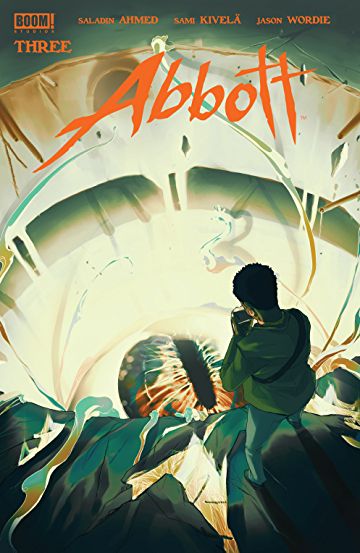Abbott #3
Posted on March 31, 2018 by John Elrod II in Abbott // 0 Comments
Previously: Abbott #2.
This month’s issue is all about jobs, and not in the deceptive manner in which the Roseanne reboot wants you to think it’s about jobs. This is about jobs in a more substantial way; it’s about the power some jobs provide certain-white-people, and how that power is used and abused by said people. Kind of like how someone in the entertainment industry could use their power to propagate the false narrative of “economic anxiety” and ignore the reality of racism and white privilege. Yeah, sort of like that.
The writing here is terrific. Abbott‘s first two issues have been written very well, too, so I’m not surprised, but the self-contained narrative of this issue is even a step above previous issues. I’m going to spoil this one; I usually try to avoid major spoilers, but it’s sort of difficult to talk about this issue in any kind of meaningful way, without spoiling what happens, so be forewarned.
The issue begins with yet another excerpt from an article Elena has written titled “Lean Times on the Factory Line”. I continue to love this series’ use of these articles, and how this one is utilized is exactly why. This article is about a factory closing in Detroit, which basically means more people will be out of work, and more people will be leaving the city. Beyond its usefulness to this issue’s story, I also like how this article is not about crime or the police; this is Elena Abbott writing about the city and its people, apart from unsolved murders and police violence. It gives the character more depth than if you just have her focus on material directly pertinent to the case currently at the center of the series. What’s more, it does well to expand the series and grow the city of Detroit into more of its own character existing alongside Elena, which is something I’ll touch on more when I discuss the art.
This issue doesn’t leave police violence behind, though. Of course not, because the problem of police violence and the corruption of our police power structure is all over this entire series, so it comes up multiple times. Early on, we learn Wardell has gone missing; when Elena suggests going to the police, Broadway says he doesn’t want to do that because, “They’re as likely to shoot him as to find him”, a statement that would be more chilling if how true it is didn’t make it so sad.
Abbott is set over 40 years ago, but this is a reality we still know all too well today. In 2018, Elena Abbott would be writing about the police killing of Stephon Clark, the police officers who killed Alton Sterling going uncharged, or the numerous other acts of police violence we continue to see against black people. As much as Abbott does a good job of grounding itself in the world of 1970s Detroit, it’s also doing well to highlight how the problems we had continue to be the problems we have.
Later in the issue, we see Elena visit the office of someone who knew she was coming. This scene ultimately results in her asking a secretary for help. Does she get help? No. The secretary is a white woman, and the person Elena is running from is the secretary’s white, male boss. Instead of getting help, Elena gets gripped up by a white security guard and removed from the building. But the security guard is instructed to “be gentle with her”, so I guess she should be grateful for that, right?
The third instance where power dynamics come into play is a familiar one Elena has dealt with the entire series: the higher-ups at the paper don’t like her, especially given her propensity to tell the truth about the police. We’ve seen this coming for two issues now, and it’s been a constant threat, but it still stings when Elena is finally fired from the paper. This allows Elena’s article about a closing factory to bookend the issue; now she has gone from writing about the ills of the city affecting people, to being directly affected herself. If the Elena character didn’t already feel like she was actually a part of the city and on the same level as the people she’s writing about, she does now.
I wanted to go through those scenes, and unfortunately spoil them, because, while they are about jobs on the surface, they don’t merely highlight how certain jobs give people power. In our world, being white is, in itself, a position of power. These scenes are demonstrations of how the systemic racism of our system makes being a person of color a constant power struggle.
This dynamic is integral to what makes Abbott work. In recent days and weeks, a lot has been said about stories reflecting “real people”, because of the aforementioned reboot of Roseanne. Believe me when I say I loved the original run of Roseanne, and still do. However, it’s often held up as a bastion of representation for “real people”, as if it were the only television series addressing actual issues. That’s ridiculous, of course. At the same time, that show truly did personally reflect my life more than other shows I had seen. It was a blue collar family with two working parents, for one. Furthermore, Roseanne worked at a factory; my mom worked at a factory. Dan was a mechanic; my dad was a mechanic. They were poor; I was poor. So, yes, Roseanne did feel like the closest thing to me seeing my family on television. But that show ended 20 years ago, and it didn’t come back.
The Roseanne reboot is a fantasy white liberals allow their Trump-supporting relatives to tell themselves, so we can all go on pretending we like each other. Abbott is set in a 40-year-old world awash with occult themes, events, and creatures, but it does more to reflect the reality we live in than any television series built on lies white people have the privilege of being able to let themselves believe.
The artwork from illustrator Sami Kivelä and colorist Jason Wordie continues to shine. Sami Kivelä has quickly become a favorite artist of mine, and it has so much to do with his use of dynamic staging. I won’t belabor the point, since I’ve gushed about it in previous reviews, but the character positioning is just fantastic. Not only does he play with perspective, in relation to characters, but he has also helped make Detroit feel like an independent character in the series by continually placing scenes across a room full of people or behind trees. The city has a presence, and it needs to have that presence. For a story like this to really sell, the reader needs to feel as though they are well-oriented within the setting, and you absolutely do.
Beyond that, the occult events taking place in Elena’s life routinely provide an opportunity for Kivelä and Wordie to explode the subdued, natural tones of Elena’s ordinary life into bursts of erratic color; that happens here, and it creates some magical panels in this issue.
In the back matter, we get promos for several Boom! Studios series, including: Power Rangers: Shattered Grid, an event marking the 25th anniversary of Power Rangers, and Lucy Dreaming, a new series from Max Bemis (Moon Knight) and Michael Dialynas (The Woods); as well as a profile of Boom! Studios associate editor Chris Rosa.
If you can’t tell, I love this series. We’re only three issues in, but it is consistently telling a meaningful story and telling it really well. I want to say this is my favorite issue, so far, but I also want to say I have felt that way about every issue. I don’t expect issue #4 to end this streak, but it does have a tough job ahead of it.
Abbott #3 Review Score
-
Plot – 10/1010/10
-
Dialogue – 9.5/109.5/10
-
Art – 9.5/109.5/10
-
Cover – 9.5/109.5/10
-
Back Matter (Letters section, additional material, etc.) – 8.5/108.5/10
Abbott #3 – Chapter Three: "Ball of Confusion"
Writer: Saladin Ahmed | Illustrator: Sami Kivelä | Color: Jason Wordie | Letters: Jim Campbell | Cover: Taj Tenfold | Designer: Michelle Ankley | Editor: Eric Harburn | Associate Editor: Chris Rosa | Publisher: Boom! Studios



